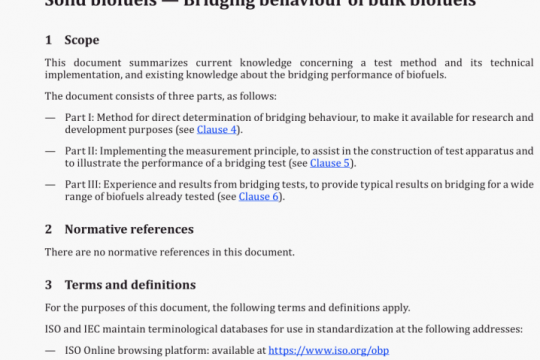ISO 1328-2 pdf free download
ISO 1328-2-2020 pdf free download.Cylindrical gears一ISO system of flank tolerance classification一 Part 2: Definitions and allowable values of double flank radial composite deviations.
4.4 Application ofthe ISO flank classification standard
4.4.1 Measurement equipment and master gears
When measurement according to this document is specified, the double flank equipment for the gears being measured is to be calibrated and appropriate. Unless otherwise agreed upon, the manufacturer may select the double flank equipment to be used.
A master gear shall be used for double flank radial composite tests. The design of the teeth, including specified tolerances, ofa master gear shall be agreed upon between the manufacturer and purchaser of the product gear. Master gears are subject to wear and damage during use and should be periodically calibrated and traceable to national standards, with a stated measurement uncertainty.
NOTE Master gear deviations can increase or decrease the measured deviations in the test gear. Therefore, parts requiring higher levels of precision normally require more precise master gears. The use of lower quality masters will increase the risk offalse acceptance or rejection ofa product gear.
There shall be no gear mesh interference between the product gear and the master gear. Interference between the tips and fillets at the minimum center distance during measurement should be checked. Minimum total contact ratio should be checked, and its value should be greater than 1,02 with all tolerances applied.
4.4.2 Equipment verification and uncertainty
The equipment used for the measurement ofgears should be verified periodically.
The uncertainty ofthe measuring process should be determined, see ISO 14253-1.
4.4.3 Filtering and data density
Tooth-to-tooth radial composite deviation can be greatly influenced by runout, especially on gears with low numbers of teeth. Some double flank equipment may have the option of using filtering techniques to report tooth-to-tooth radial composite deviations after removing the effect of eccentricity. The tolerance values in this document shall be applied without the use of filtering that removes the effects of eccentricity.
Other filtering can occur due to the mechanical dynamic frequency response of the moving pieces of the tester including the effects from the mass of the gear itself, mass of the moving head, frictional resistance of the measuring system, and the spring. Slower rotation during testing reduces the effect of this filtering due to mechanical dynamic response.
When an electronic measuring device is used, a minimum of 30 data samples per tooth pitch should be taken.
4.5 Acceptance criteria
The double flank radial composite tolerance class of a gear is determined by the larger class number measured for the tolerance parameters specified for the gear by this document.
The tolerances for double flank radial composite deviations apply to the inspection of a gear meshing with a master gear. Use of double flank radial composite tolerances on two product gears meshing together should be agreed upon between the manufacturer and the purchaser.
4.6 Correlation of double flank radial composite and element deviations
The tolerance class determined for a gear measured with the double flank radial composite methods of this document does not correlate to the class determined for that gear by the elemental methods covered in ISO 1328-1. Users are cautioned that specification to this document alone may not properly control deviations of index or total cumulative pitch that can occur without radial deviations. See ISO/TR 10064-1 and ISO/TR 10064-2 for more information on index deviation.
4.7 Designation of the double flank radial composite tolerance class or tolerances
Designation/specification of a double flank radial composite tolerance class in accordance with this document shall be as follows:
ISO 1328-2:2020, class Rxx
where xx designates the design double flank radial composite tolerance class.
NOTE If the year of publication is not listed and previous standard qualifier class is not listed, the latest version of ISO 1328-2 applies.
5 Tolerance values
5.1 General
The tolerance values are calculated by the tormulae given in 5.3- and 5.4. In addition, the tormula in 1A may be used to calculate the optional double flank radial composite deviation over segments of k teeth.
NOTE Annex E provides tolerance calculation examples.
When the gear diameter or number of teeth is not within the specified range listed in Clause 1, use of the tolerance formulae shall be agreed upon between manufacturer and purchaser.
The double flank radial composite classification system is comprised of 21 tolerance classes for total and tooth-to-tooth radial composite deviations of which class R30 is the most accurate and class R50 is the least accurate.
5.2 Use of formulae
5.2.1 Number of teeth used to calculate tolerances
For gears with more than 200 teeth, except for sector gears, a default value of 200 shall be used for the number of teeth.
For sector gears, z is the equivalent number of teeth based on extending the sector to cover 360° around the gear’s axis of rotation.
5.2.2 Rounding rules
Values calculated from Formulae (1). L4J. and (.5j shall be rounded to the nearest micron. If the fractional result is equal to 0,5, the value is rounded up to the next integer.ISO 1328-2 pdf download.




